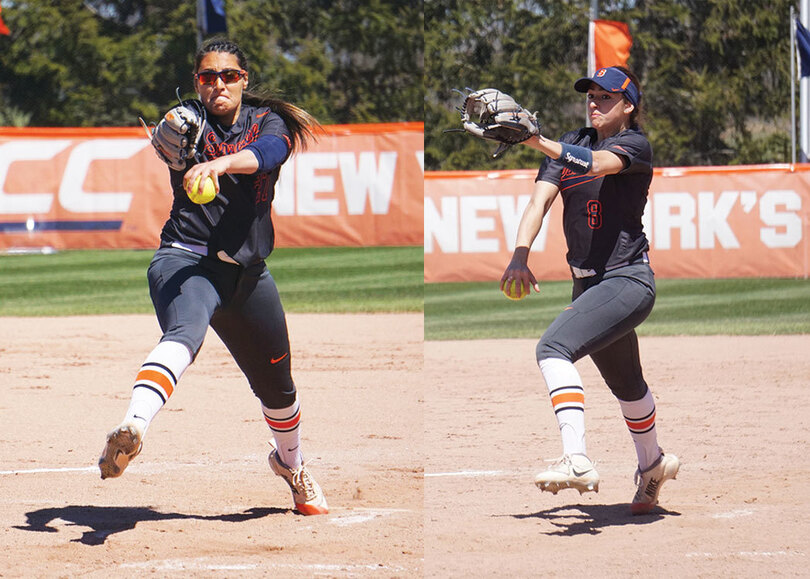Visors or not? Players explain game day headwear choices

Miranda Hearn (right) who pitches and plays infield often wears a visor while Alexa Romero (left) doesn't. Jordan Phelps | Staff Photographer
Alicia Hansen knew exactly where she was supposed to be. As soon as the Boston College batter hit the ball, the center fielder ran to her spot. Hansen stood directly under the ball, but as she looked up, she couldn’t find it.
She shifted her glove to block the glare of the sun, hoping to see the ball better. It didn’t work. The sightline to the ball was blocked by Hansen’s glove for the last 10 feet of its drop.
Until the ball landed on her forehead.
Hansen wasn’t wearing a hat or sunglasses. She never does. She is one of the few Syracuse (26-18, 8-11 Atlantic Coast) players to not wear a hat during games. Many players wear at least a hat or sunglasses to keep the sun from impacting their play –– but if a player chooses to not wear them and makes an error as a result, it’s the player’s fault, Hansen said.
“If I was wearing sunglasses or a hat and then I missed that ball then it probably wouldn’t have been as big of a deal because I was wearing something to try and block the sun,” Hansen said.
SU head coach Mike Bosch recommends his players wear something to block the sun. He always checks what the sun will be like on game day. Whether Syracuse is on the road or at home, Bosch likes to get to the field a day early and see how the sun hits the stadium.
The NCAA doesn’t mandate headgear. Under section 3.10.1 of the NCAA softball handbook, “Visors and caps are uniform accessories, may be mixed, and must be of the same predominant color and worn as intended by the manufacturer.” For SU, the predominant color used on hats and visors is blue.
On March 31 against Boston College, one Syracuse player did go a different route in hat color: In game two of a doubleheader, pitcher AnnaMarie Gatti entered the circle wearing a camouflage hat with an orange S on the front.
Her dad can be superstitious, she said, which is why she wears the hat. During previous seasons, Gatti wore a camouflage hat during home games and each time she wore it, she pitched well. Most notably, she wore it her sophomore year against then-No. 19 Notre Dame, when SU ended the Fighting Irish’s 19-game winning streak.
“It probably didn’t have anything to do with the hat,” Gatti said. “Clearly, because I had been throwing games without it earlier in the season, but every time I threw in that hat I would have a good game.”

Kevin Camelo| Digitial Design Editor
The Boston College game in March was the first home game Gatti threw this year. It was also the first game her parents attended. Her dad asked why she wasn’t wearing her hat. Gatti didn’t know where it was, she said, and she hadn’t been wearing it all season.
“I was warming up and he like threw me this hat,” Gatti said. “It was way different than the camo one. He was like, ‘Maybe this will bring something good.’ I was willing to try it.”
She ended up throwing one of her worst games of the season, allowing seven hits and a season-high eight runs in the 12-2 loss to Boston College. The next time she was in the circle at home, Gatti wore a blue visor.
Alexa Romero, Syracuse’s other main pitcher, never wears a hat. When she pitches, her arm gets very close to her head, and a hat would get in the way. She wear sunglasses instead.
Hansen wore a hat once in her sophomore year when she was playing second base but at one point during the game, she looked up to catch the ball and felt constricted, she said. All she could see was the brim of her visor.
Usually, both of Hansen’s outfield sidekicks — Bryce Holmgren in left and Toni Martin in right — wear a hat or visor. Martin never wears sunglasses because she never did growing up. But she almost always wears something to block the sun.
“Whether I wear a hat or a visor,” Martin said, “it just depends on what my hair looks like that day.”




